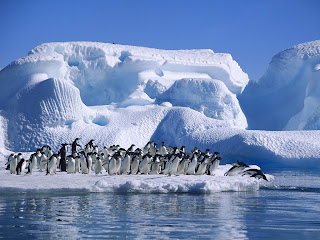General Info :
The Adélie Penguin (Pygoscelis adeliae) is a species of penguin found in Antarctic coast. They are among the most southerly distributed of all seabirds, as are the Emperor Penguin, the South Polar Skua, the Wilson's Storm Petrel, the Snow Petrel, and the Antarctic Petrel. In 1840, French explorer Jules Dumont d'Urville named them for his wife, Adèle.
Physique :
These penguins are medium in size, being 46 to 75 cm (18 to 30 in) in length and 3.6 to 6 kg (7.9 to 13 lb) in weight.
They have white ring around their eyes and the
feathers at the base of the bill. These long feathers hide most of the
red bill.
They are a little smaller than other penguin species. Their appearance
is closest to the image of penguins as mostly black with a
white belly.
Adélie penguins can swim up to 45 miles per hour (72 km/h).
Diet :
The Adélie penguin's diet varies depending on geographic location during the chick-rearing season. The stable isotope record of fossil eggshell
accumulated in colonies over the last 38,000 years reveals a sudden
change from a fish-based diet to krill that started two hundred years
ago. This is most likely due to the decline of the Antarctic Fur Seal since the late 18th century and Baleen whales
in the 20th century. The reduction of competition from these predators
has resulted in a surplus of krill, which the penguins now exploit as an
easier source of food.
Distribution :
There are 38 colonies of Adélie penguins, and there are over 5 million Adélies in the Ross Sea region. Ross Island supports a colony
of approximately half a million Adélies. Adélie penguins live in groups called colonies.Around 160,000 Adélie penguins live at Cape Bird, but ecologists are predicting as many as 70 percent of them could be wiped out due to sea loss.














No comments:
Post a Comment